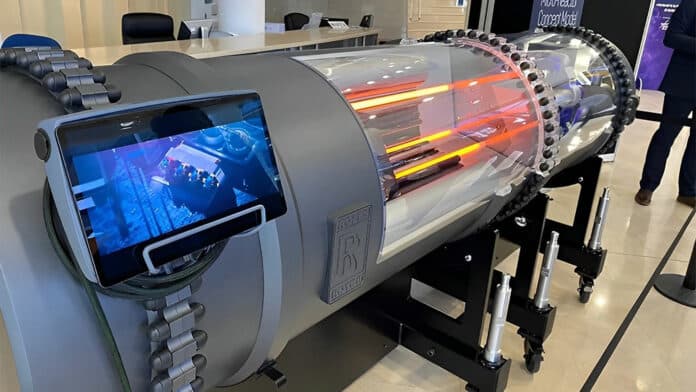At the UK Space Conference in Belfast last week, the U.K. tech giant Rolls-Royce unveiled a nuclear Space Micro-Reactor Concept Model that could power a future outpost on the moon.
The mini reactor seems to be quite small and is not yet capable of generating any electricity. But if all goes according to plan, it will take about six years and a few million dollars to get it ready for its debut space trip.
Some parts of the Moon’s southern pole have been in permanent darkness for billions of years. This fact makes these regions incredibly harsh and hostile to human life. However, NASA sees this area as a promising location for the first lunar outpost. This choice is primarily due to the potential for vast water deposits within the shadowed regions.
To survive and carry out operations in this area or any other lunar location, astronauts will require a steady supply of power. Since solar energy is not a reliable source, there is a high need for a nuclear power plant on the Moon to ensure the successful establishment of a lunar settlement.
Rolls-Royce secured funding of £2.9 million from the UK Space Agency in March 2023 to support their research into how nuclear power could be used to assist in establishing a future Moon base for astronauts. The technologies that were presented at the UK Space Conference are the result of this year’s research, which involved scientists and engineers at Rolls-Royce working alongside their strategic partners.
“This funding has enabled crucial research and development of technologies that bring us closer to making the Micro-Reactor a reality. Our Space Micro-Reactor Concept Model allows us to demonstrate how this technology will bring immense benefits for both space and Earth,” Abi Clayton, Director of Future Programmes for Rolls-Royce, said in a statement. “Micro-Reactor technology will deliver the capability to support commercial and defense use cases alongside providing a solution to decarbonize industry and provide clean, safe, and reliable energy.”
The research focused on three key features of the micro-reactor, which are the fuel used to generate heat, the method of heat transfer, and the technology used to convert that heat into electricity.
All space missions depend on a power source, and, as a self-contained and power-dense solution, a Micro-Reactor can provide power for the habitation and exploration of a planetary surface or power and propulsion for spacecraft. Continuous power and efficient propulsion can also provide satellites with more flexible movement to protect and defend key orbits.
Relatively small and lightweight compared to other power systems, a nuclear Micro-Reactor could enable continuous power regardless of location, available sunlight, and other environmental conditions. Rolls-Royce plans to have a reactor ready to send to the Moon by the early 2030s.
The potential applications of Rolls-Royce Micro-Reactor technology are indeed quite diverse and can be useful in both commercial and defense sectors. Besides space-related applications, the technology can be leveraged for various purposes. The ultimate goal is to create a powerful and efficient propulsion capability that serves the needs of different markets while also supporting global targets for achieving net zero emissions.
Rolls-Royce is currently looking into ways to convert the heat generated by nuclear fission in space into electricity. The engineers are currently working on a simpler and more suitable solution for space technology than the conventional method used on Earth, which involves boiling water to create a pressurized steam that powers a turbine.
“This innovative research by Rolls-Royce could lay the groundwork for powering continuous human presence on the Moon while enhancing the wider UK space sector, creating jobs and generating further investment,” Dr Paul Bate, Chief Executive of the UK Space Agency, said in a statement.
